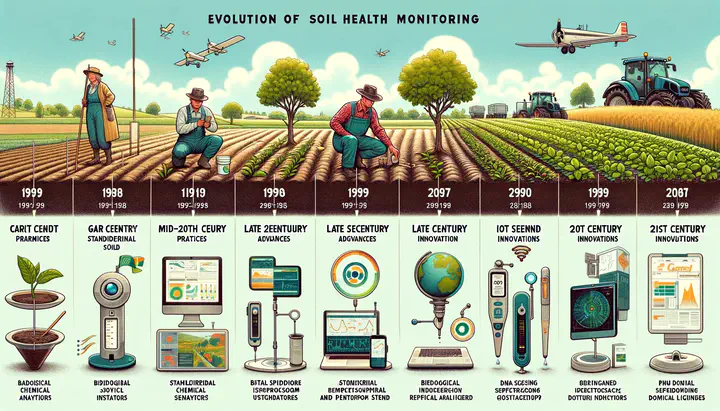Unearthing the Fundamentals of Soil Health and Monitoring Techniques
 Image credit: Evolution of Soil Health Monitoring
Image credit: Evolution of Soil Health Monitoring
From a young age, my curiosity about agriculture was nurtured by my upbringing around India’s prestigious ICAR-Indian Agricultural Research Institute. Walking through experimental greenhouses and soil testing labs, I was captivated by the science and techniques involved in agriculture. My annual visits to the Krishi Mela, a farmers market showcasing innovative agricultural techniques, further fueled my interest.
Today, let’s delve into an essential component of agriculture—soil health. Soil health is the foundation of productive farming, enabling the soil to function as a vibrant ecosystem that supports plants, animals, and humans. It plays a critical role in regulating water, sustaining biodiversity, filtering pollutants, cycling nutrients, and providing stability for both natural and man-made structures. Soil health monitoring is the practice of regularly assessing soil properties to gauge its condition and ability to support plant growth and ecosystem services. This includes analyzing physical, chemical, and biological indicators like soil texture, nutrient levels, and microbial activity. Such monitoring helps detect changes or degradation in soil quality over time, guiding sustainable land use and agricultural productivity.
Monitoring techniques range from simple physical assessments of soil texture and structure to advanced methods like spectroscopy and remote sensing. Innovations such as real-time IoT sensors and AI integration are setting new standards in how we understand and manage soil health. The journey from basic visual inspections to high-tech soil analysis reflects advancements in technology and an expanding understanding of soil’s role in our environment. Initial methods included visual assessments and basic chemical analyses, which evolved through the development of standardized soil testing and mechanical tools like penetrometers that provided more quantitative data. The incorporation of biological indicators, digital mapping, GIS, and remote sensing has revolutionized soil health monitoring.
Several key players are driving innovations in this field: Agilent Technologies and Thermo Fisher Scientific provide advanced analytical tools; Trimble and Yara International integrate precise technologies with agricultural practices; Soil Health Institute promotes research and sustainable practices; Sentek Technologies, AquaSpy, and METER Group specialize in real-time monitoring systems. The contributions of these technologies and companies are profound: they enhance agricultural productivity by allowing precision in soil management, which leads to better crop yields; they reduce environmental impacts and promote resource conservation; they increase profitability for farmers through optimized resource use; and they support compliance and policy-making with accurate data.
Soil health monitoring not only supports agricultural productivity but also plays a vital role in environmental sustainability and economic stability. As technology evolves, so does our ability to maintain and enhance the health of our planet’s soil, ensuring a fertile and sustainable future for all.
Some of the reading references:
- https://www.nrcs.usda.gov/conservation-basics/natural-resource-concerns/soils/soil-health
- https://www.ncbi.nlm.nih.gov/pmc/articles/PMC7116140/
- https://ejpsoil.eu/fileadmin/projects/ejpsoil/WP5/PhD_School_material/Soil_Systems/Literature_meeting_III/Lehmann_NatureReviewsEarthEnv_2020_.pdf
- https://www.startus-insights.com/innovators-guide/soil-monitoring-trends/
- https://www.ventureradar.com/keyword/soil%20health
- https://www.f6s.com/companies/farm-monitoring/mo
- https://www.marketresearchfuture.com/reports/soil-monitoring-market/companies